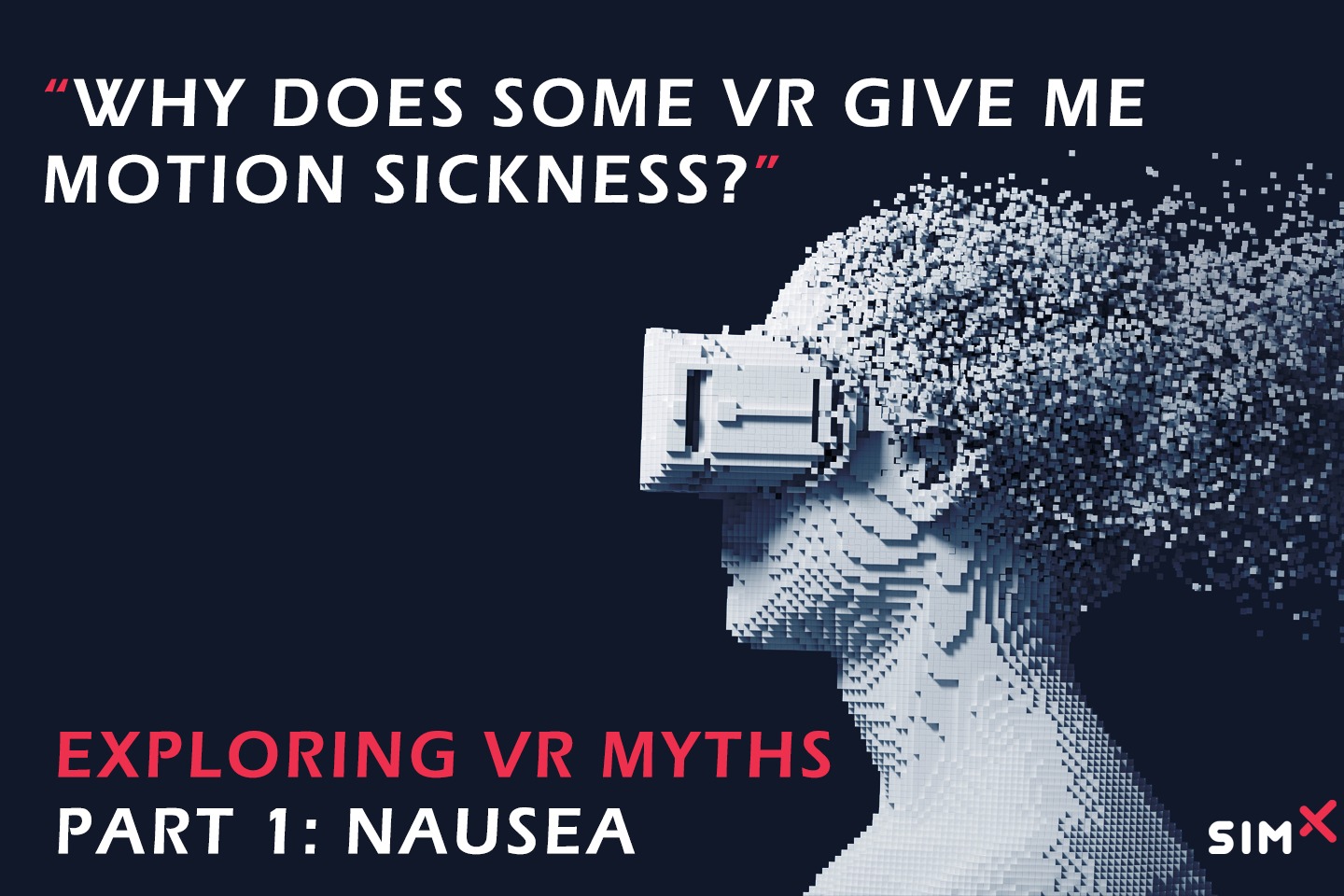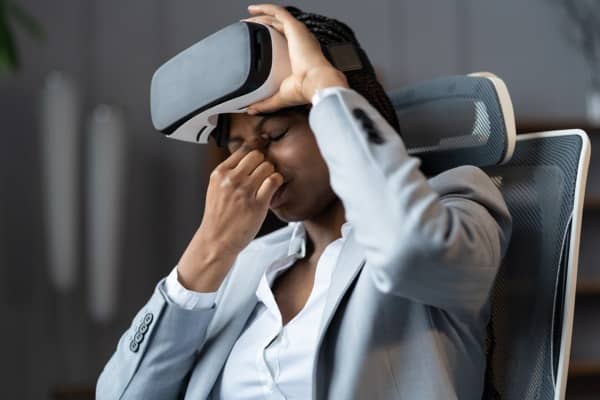SimX is completely changing the way healthcare providers undergo simulation training. For decades, patient manikins have evolved to incorporate varying...
VR Myths And Misconceptions Part 1: Nausea

Will VR Make Me Sick?
The most popular myth is that VR will always make you sick. If you’ve ever experienced nausea, dizziness, or headaches after using a headset, it’s possible you’ve suffered from VR or cybersickness. Similar to motion sickness, VR sickness can happen for a variety of reasons and may emerge after only a few minutes in the headset or a few hours. Experiencing VR sickness or even hearing about it may be enough to put you off VR altogether. While VR sickness can happen, it is a myth that VR will always make you sick. As you learn more about the features and circumstances that typically cause VR motion sickness, you can start to optimize your VR experience and in doing so, allow yourself to enjoy the fruits of VR.
This exploration into VR motion sickness is the first part of an ongoing series debunking common VR myths and misconceptions that keep users from truly discovering all that virtual reality (VR) has to offer.al
VR, Cybersickness, and Motion Sickness
There’s little difference between the nausea you feel from VR (also known as “cybersickness”) and what you may feel while driving on windy or rough roads. Both forms of motion sickness happen because your brain is receiving mixed signals; you feel that you are physically standing or sitting still but everything around you is generating motion. In other words, there is a disparity between what you see and what your body is doing. When your senses are reporting contradictory information to the brain and the result can be disorientation and physical symptoms. Many immersive VR experiences even add another level of disorientation as the user may be driving, running, or even riding a roller coaster in expansive environments.
Fortunately, through the careful selection of VR experiences, these sensory incongruities can be eliminated. In doing so, the symptoms of cybersickness can be reduced and even eliminated altogether.

The Environment Matters
Studies have shown that a major indicator for VR sickness is the virtual environment. Significant differences were found in the amount of motion sickness user’s experience when moving from pleasant environments to frightful or horrifying environments. In fact, virtual environments have such an impact on a user’s well-being that notable differences were found in blood pressure and heart rate as users navigate their virtual space (see sources below).
To avoid VR sickness caused by virtual environments, make deliberate decisions regarding which VR games and applications you engage with. Choose environments that are brighter, more static, and responsive to physical movement (i.e. walking in place, moving your arms).
Locomotion
If you often experience motion sickness in VR, your movements in virtual space are likely to blame. The system that enables you to move within a virtual world is called locomotion. There are many approaches taken by games and other applications to enable movements. Since many people have only a small space in the real world to use VR, some applications make use of joystick-based locomotion. In this approach, users use their controller to indicate the direction in which they want to move, and their virtual viewpoint moves in that direction freely.
Though this approach mirrors the screen-based games that many people play on computers and consoles, it can cause significant cybersickness in VR. This is because joystick-based locomotion accentuates the conflict between your senses: your eyes can see you moving through the virtual world, but your body knows that you are keeping still. This incongruity can rapidly induce cybersickness that can stay with some people for hours, and the faster the movement, the worse the symptoms. Others, however, experience few or no symptoms from this mode of locomotion, and scientists are still investigating why there are such differences in different people.
For those who do suffer from this kind of cybersickness, there are simple solutions. An easy solution is to switch to teleportation-based locomotion. In this mode, users can use a control device to select a location on the ground that they wish to move to, and then the application will teleport you to that location. Though this can still cause symptoms in some people, most find that it resolves their problem.
For the ultimate solution to locomotion-induced cybersickness, room-scale locomotion is required. In this approach, in order to move around the virtual space, you must physically move in the real world. This approach ensures that there is no discrepancy between your eyes and your body, eliminating cybersickness (see sources). However, this approach is not always practical as it limits how far you are able to travel in the virtual world, based on the available physical space. Applications must be deliberately designed to maximize utility and enjoyment in the limited space.
High Quality Content
Optimizing your VR experience also requires you to select high quality content and applications. Just as certain modes of VR locomotion can induce cybersickness, so can poor quality content. Much like movies and games on TVs and computer monitors, VR content displays within the headset at a certain number of frames per second (FPS). When the FPS rate is low, the VR scene may appear jerky. These jerks will create an incongruity between what your eyes see and what your body feels, potentially inducing cybersickness.
Another related factor is the delay (also known as latency or lag) of the displayed content. If there is a delay between the movement of your body (i.e. turning your head) and updates of the virtual view in your headset, it will also cause an incongruity between your senses that can quickly cause cybersickness. To avoid this effect, display latency must be very low (ideally under 100 milliseconds) – content with higher latencies may cause symptoms even though the difference is too small for you to notice.
Both FPS and latency are functions both of the quality of the hardware you are using, and the quality of the software and content you are using. Content must be carefully programmed and optimized in order to provide the best visual experience and thus eliminate sources of cybersickness.
Additionally, some software allows you to select graphics options or settings at different quality levels. If you are able to configure these settings, be sure to select a level that produces good performance on your particular hardware; otherwise, your headset may not have the power to create the visual scene at high FPS and low latency, and sickness may result.
6DoF Hardware
Optimizing your VR experience includes choosing a high quality headset to create the virtual world. This does not necessarily require spending a lot of money, as a wide variety of high-quality headsets are available on the market today at different price points. One specification to pay attention to when searching for the right headset is the Degrees of Freedom (DoF) tracking system, which allows a user’s movement to be translated into virtual movement. Older generation headsets are limited to 3 Degrees of Freedom (3DoF), which refers to the number of directions a rigid object can move in 3-dimensional space. 3DoF systems can only track a user’s rotational movement. Most newer models operate with 6DoF, which also tracks a user’s transitional motion–moving forward, backward, up, and down (see sources). This motion tracking technology plays a large role in a user’s comfort levels and wellbeing while in the headset. Using headsets with only 3DoF limits translatable movement, increasing the mental disparity between a user and the virtual avatar. s leo.
How SimX Eliminates Cybersickness
Here at SimX, we understand that cybersickness can ruin the educational experience of learners and faculty alike – and indeed, many of the original founders of SimX suffer from severe motion sickness in cars, boats, and planes! As a result, SimX has created its software from the very beginning to eliminate cybersickness. In order to accomplish this, we use a variety of avenues to eliminate the problem.
At SimX, we make use of room-scale locomotion, and match VR movement to a user’s physical movement. For example, we require users to walk freely around the clinical environment and reach for items or tools rather than selecting them from a drop-down list of options. We provide minimum size specifications for the physical playspace used for every scenario in order to ensure that you can walk freely throughout the case. Mimicking natural and intuitive movements also helps translate VR simulation training directly to real-world patient care, providing a more immersive training experience.
SimX also custom designs all environments and other parts of the VR scene to ensure they are clear, detailed, and sufficiently bright. This ensures that the environment is not a contributor to cybersickness. All SimX content goes through a rigorous testing process on each of the headsets supported by SimX. This ensures that all SimX content has a high FPS and low latency level, no matter which supported headset platform you use.
By ensuring high FPS and latency, making use exclusively of roomscale locomotion, limiting hardware to high-quality, tested headsets, and optimizing environments and other VR content, SimX ensures that learners and educators alike will have a positive experience and minimize the possibility of cybersickness or discomfort.
Get in a Headset
To really know if a VR experience will cause motion sickness, you have to try it for yourself. Relying on hearsay or how another user felt after using a different VR platform or application will continue to perpetuate the myth that VR always makes you sick. In reality, VR can be optimized in many different ways to improve your experience and increase a user’s comfort level in any VR program. What content you engage with, the quality of your system, and your hardware specs all influence VR sickness symptoms.
SimX offers free demos for interested users of any VR experience level. Our representatives can help you optimize your VR sessions to your comfort level so you can have a truly immersive and engaging VR experience. With over 250 unique, tested and certified scenarios in our marketplace, we ensured that our content has the quality required so you and your team can engage with the best that VR medical simulation has to offer.
Sources:
(https://ieeexplore.ieee.org/abstract/document/9133071) U. A. Chattha, U. I. Janjua, F. Anwar, T. M. Madni, M. F. Cheema and S. I. Janjua, “Motion Sickness in Virtual Reality: An Empirical Evaluation,” in IEEE Access, vol. 8, pp. 130486-130499, 2020, doi: 10.1109/ACCESS.2020.3007076.
